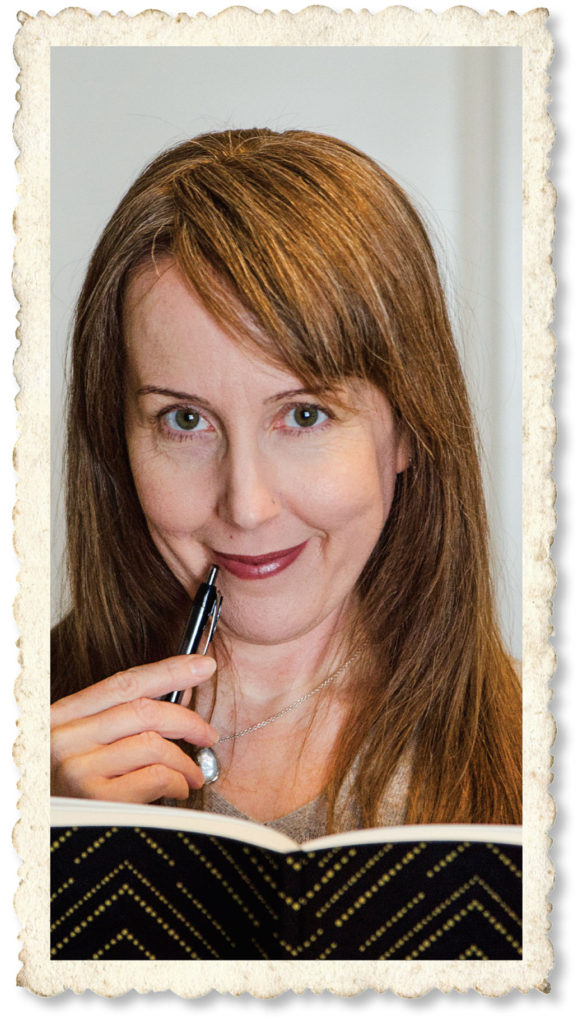




Deborah Zak’s Diary
Confessions of a mission-centered editorial manager
By Deborah J. Zak
January 3, 2017
Back in the office — start of the new year! Looking forward to implementing the new editorial calendar for planning publication content and supporting editorial staff with new trainings on how to stay mission-focused. We’ve assembled a rock-star team; now it’s time to grow them to the next level. Piece of cake! Yeah, right. Honestly, dear diary, I’m a bit nervous. Spent New Year’s Day avoiding thinking about this; binge watched all the Bridget Jones movies — in my pajamas, with a glass of wine. Only instead of sadly singing “All by Myself” like Bridget, I was fearfully singing Led Zepplin’s “Communication Breakdown.” Hope that’s not where we’re headed. Oh wait, maybe Bridget can help. She’s socially awkward, sometimes flighty, and often unprofessional, but she went above and beyond her career goal and became the new face of British TV journalism. If she can meet her goal, so can I. I can help our team better engage members with our content — I got this!
I’m sure many of you have experienced this same mix of excitement and trepidation when faced with a new initiative. At the National Association of Boards of Pharmacy (NABS), where I am communications senior manager, my team and I had a weighty goal: to sharpen our publication’s content to be more mission- and member-focused. We had just redesigned our publication, and we knew this was an opportunity to go deeper than look and feel. So we hired and developed mission-focused staff, utilized mission-focused review criteria, and implemented a long-term, mission-focused editorial calendar. And in doing all this, we have successfully fine-tuned the content of our primary member publication, Innovations, to better communicate our association’s work and messaging, while giving members more of what they want and need. It wasn’t easy, and it wasn’t always smooth sailing. But thankfully, I took some valuable tips from a seemingly unlikely source of wisdom: my comic heroine, Bridget Jones.
Beyond Words: Benefits of Staff Who Value the Mission
February 5, 2017
I can’t believe my staff struggled to state our mission statement during the meeting today! Two of them also didn’t know the basics of some of our programs. Feeling a bit like Bridget when she and her film crew blew it on the high-profile court interview. I’ve really missed the mark here. Now I understand why my staff doesn’t make enough edits on our newsletter copy. They don’t have context! Thank goodness I already planned these training sessions. Well, Bridget had to read a bunch of self-help books to get on track with her goal. I guess everyone needs a little continuing education now and then, myself included.
Why was I so concerned about our staff knowing the organization’s mission by heart and understanding the ins and outs of its programs? It’s the editorial shop after all; aren’t research, writing, and editing the main skills? Aren’t laptops, Google searches, commas, and dashes the primary tools?
I had seen the results in the content we were drafting and how much work it needed before being ready for publication. I knew that if staff members are confused about the mission or, worse, simply don’t value it, all the editorial tools and processes in the world won’t create effective, impactful content. So, how do you develop a truly mission-focused editorial staff? Start with the five strategies we used at NABP.
1. Know Your Mission
Ensure that your direct reports know your organization’s mission statement and that they reinforce it with their respective staff. This step may seem simple, but it takes intention and can easily get lost amidst day-to-day responsibilities.
At NABP, staff across all departments, including editorial, benefit from an organizational culture that is consistently mission-focused from the top down. Executive staff and the elected officers and executive committee of the association (aka, the board) consistently reinforce our mission — which is to protect the public health — by reading it at every association business session, committee meeting, and task force meeting. Senior staff reiterate the mission at staff meetings. And, our communications department ensures that our statement is printed in almost everything the association publishes. This consistent repetition puts our mission at the center of all decision-making. And our editorial staff benefits from an association culture that’s steeped in the mission such that it becomes second nature to edit all content with this purpose in mind.
If your association doesn’t reinforce its mission in such intentional ways, it may be time to consider raising the issue with senior or executive level staff who can help shift the momentum in the right direction.
2. Know Your Role
If your editorial department doesn’t have its own mission statement, write one.
A mission-focused organizational culture sets the stage, but individual departments need to know their respective missions, too. This ensures that staff understand how their work supports the overall organization. If a mission statement already exists for your publication or editorial department, meet with staff to discuss how they see themselves carrying it out in practice. If no such statement exists, or the current one needs revision, do the hard work of creating or revising it as a team. Brainstorming and drafting the statement together will ensure it takes into account various perspectives and will give the team a sense of ownership and motivation for carrying it out.
The mission of the editorial team at NABP is clear: To develop a publication that educates members and the public about our association and its purpose. In the past year, our editorial department has seen some turnover as we replaced promoted staff with new hires. As new employees settled into their roles, and others took on new responsibilities, we saw a need to ensure everyone was still focused on the mission and had a plan for getting the newsletter to the next level. I met with our editor to revisit our mission statement and craft a “vision statement” that laid out our five-year goals for the department and how we planned to accomplish them. We avoided looking at current written statements and instead faced a blank white board together. We brainstormed answers to questions such as: What is the purpose of our newsletter? What content do members need and value? How can we better engage our members? What tools can we deploy in editorial to enhance content? What improvements should we make in the next five years? Starting with a blank page allowed us to deconstruct and freshly reconstruct the newsletter’s mission and vision, and then set new goals for the coming years.
3. Hire Like Minds
Hire staff that are committed to the association’s mission.
Through trial and error, we have learned that hiring staff who want to be part of a larger mission is key to successful editorial. During interviews for any position, from administrative to proofreader, copyeditor to technical writer, we ask questions that give candidates an opportunity to share why they want to work for our association. Even if they’re still learning about us, their answers should demonstrate at a minimum that they researched our purpose, are interested in learning more, and value the non-profit environment. We’ve come to find that if their answers focus exclusively on their own careers, we may have a difficult time training them to edit content with the broader mission in mind. In the worst case, when staff show over time that they aren’t invested in the organization’s or publication’s mission, projects are at risk for missing the mark and failing to further the association’s goals.
4. Train, Train, Train
Provide plenty of opportunities for editorial staff to learn about the organization’s mission and how it’s carried out. It does no good to memorize a mission statement if staff don’t observe how it’s embodied. How can they reflect the mission in their writing if they don’t fully understand it?
At NABP, we help editorial staff learn about our mission by giving them exposure to our events, programs, and activities. This training can include attending association meetings as a reporter or observer, or participating in informal departmental trainings delivered by program experts. When I joined NABP, I gained a lot from attending NABP task force meetings. These include a diverse group of volunteer members who are subject matter experts on the topics discussed. I gleaned both background information for content and a better understanding of our member audience and their areas of concern and interest.
5. Set an Example
Set an example for editorial staff in your own verbal and written commentary.
At NABP, senior publishing staff consistently reinforce our mission by keeping it at the forefront of all editorial discussions and comments. Whether the conversation is about topic development, brainstorming cover art, developing an outline, or writing interview questions for a story, we ask staff to think in terms of the association’s overall goal.
For example, we hold monthly planning meetings to which we invite all senior subject matter experts to share updates from the field or from their programs. To tease out potential newsletter topics, we’ll ask questions such as, “I can see how that program enhancement helps pharmacists that use the program; how will it help our members as regulators?” or simply, “How does that development support the mission of protecting the public health?” Newer staff members get used to hearing this repeated drilling for the connection to mission, and it becomes a model for their own work.
Enhancing Editorial Processes that Drive Meaningful Content
March 15, 2017
A little frantic today. Latest issue is a bit behind schedule — just now in layout, and I’m finding a few of the articles are somehow missing the mark. I think some of the writers lost track of the primary audience and so the mission got lost as well. What would Bridget do?? OK. So, Bridget avoided the obstacles that could have kept her from her goal: the bad boyfriend, the unsupportive mother, overdoing the drink. She stuck to her goal! And she relied on her team, which eventually included Mark Darcy, who saved the day and helped her get an exclusive high-profile interview. I need to help everyone get this content back on mission.
What I lost sight of here is that once articles make the leap off the editorial calendar and enter the subsequent stages of the editorial process — development, research, writing, and editing — the focus of review and oversight has to be on adherence to mission. For every piece of content created, we have to ask: How well does it enable members to understand and carry out the association’s mission?
Writing about NABP’s CPE Monitor program is a good example. This program has several stakeholder audiences in addition to the primary newsletter audience, which is member state boards of pharmacy. CPE Monitor is an online tool that enables pharmacists to track their completed continuing education activities, assisting them in fulfilling requirements for maintaining licensure. The NABP marketing staff creates promotional material that focuses on the features of the program — the online access, the ability to manage licenses in multiple states, etc. But when it comes to Innovations, the goal is different. We need to focus our content on how the program helps boards of pharmacy ensure that pharmacists are complying with their state’s continuing education requirements — in essence, how the program helps member boards of pharmacy carry out their mission of protecting the public health.
When NABP senior editors and subject matter experts are reviewing newsletter content, the editorial discussion always centers around one question: “How does this topic/program/action relate to supporting the boards of pharmacy in protecting the public health?”
Skilled Hands, Better Tools
June 3, 2017
Editorial calendar is really paying off. Our content plans for each issue coming together more quickly and meetings with the planning board are more focused. Getting even better information from our subject matter experts, I think because we’re already starting from such a strong place. First issues out the door this year were better focused thematically as well. Yay — off to a good start. Just like Bridget Jones — ha ha. She had her diary for planning ahead and musing on the past; we have our calendar for planning content and evaluating success.
We have found at NABP that a detailed editorial calendar in the hands of mission-focused staff leads to better, more engaging newsletter content.
In the past, we planned our monthly issues two or three at a time. In 2017, we recognized the need to see the entire upcoming year’s content at a glance. NABP had launched multiple new programs and services, and it was critical to have a long-term plan for effectively communicating about each of them. By developing a detailed editorial calendar with executive and senior staff, we ensure that the various stakeholders are in sync about key themes and messaging.
The calendar at-a-glance also helps subject matter experts and editorial staff think in advance about the appropriate timing for articles. For example, in 2014, NABP launched the [dot]Pharmacy Verified Websites Program, which enables pharmacies (among other entities) to demonstrate to consumers that their website is a safe place to have prescriptions filled. Since online safety is a broad and evolving topic, we have published numerous updates and related stories since this program launch. The calendar reminds stakeholders to keep each other in the loop so we can publish relevant, timely content.
As situations emerge throughout the year and new topics or messaging become more urgent, content can be shifted around to accommodate communication priorities. We can see that certain topics need to stay in an issue because they are related to dated information or events, but other topics can be bumped over to later months to make room for important legislative or regulatory updates. Because our editorial calendar is used for internal planning purposes, we are able to treat it like a flexible, living document.
Analyze and Repeat
December 31, 2017
So excited! One of our newsletter issues won an award for editorial excellence, and the board is also happy with it. Member survey showed majority of readers find the content valuable in their work. All the efforts by the team to focus their articles to the mission and members paid off, and they developed their own training topics for future meetings. Not getting a new diary or a kiss from Colin Firth (I mean Mark Darcy) but feeling celebratory nonetheless. Next year’s calendar all set! We’re ready for another year.
Ensuring our magazine’s content consistently communicates the mission of our organization has helped us be more effective. Members are reporting to the NABP executive committee that Innovations is “valuable” to them. Association staff are culling Innovations articles to include in briefing documents that go to NABP task forces and program committees because the content is relevant. Our members are more aware of and engaged with association activities. And as acknowledgement that we’re doing something right, Innovations has been honored with two recent Excel awards from Association Media & Publishing — one for the newsletter redesign and, this year, a gold award for editorial excellence in print newsletters.
Strategies and tools — including specific review criteria and an editorial calendar — yield positive results in the hands of a mission-focused editorial staff. And, we have an advantage over Bridget Jones. While she could not edit the live footage that featured an unflattering focus on her backside, we have multiple opportunities to successfully edit with mission in mind.
These diary entries are completely fictional, but isn’t our diarist a bit like you and me?
Deborah J. Zak, Ph.D., is communications and services senior manager at the National Association of Boards of Pharmacy (NABP) where she oversees the Association’s monthly print newsletter, Innovations, along with several other publications. Prior to her nine years at NABP, she spent a decade teaching university writing and English Literature. Connect at [email protected].

